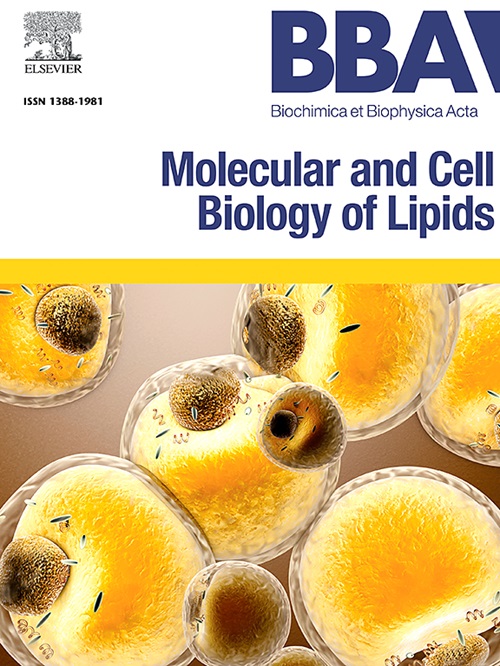The role of ancient ubiquitous protein 1 (Aup1) in regulating hepatic lipid droplet levels, endoplasmic reticulum stress, and inflammation in zebrafish (Danio rerio)
IF 3.3
2区 生物学
Q2 BIOCHEMISTRY & MOLECULAR BIOLOGY
Biochimica et biophysica acta. Molecular and cell biology of lipids
Pub Date : 2025-06-06
DOI:10.1016/j.bbalip.2025.159643
引用次数: 0
Abstract
Excessive supplementation of palm oil (PO) in aquafeeds induces hepatic endoplasmic reticulum (ER) stress and inflammatory responses in fish, while lipid droplet (LD) formation has been demonstrated to alleviate stress and inflammation by sequestering lipotoxic lipids. Studies in mammals indicate that ancient ubiquitous protein 1 (Aup1) is a LD-associated protein participating in ER-associated degradation (ERAD) and LD regulation. However, whether Aup1 is involved in the regulation of hepatic LD metabolism, ER stress, and inflammatory responses has not been elucidated in fish. In this study, we cloned zebrafish (Danio rerio) aup1, conducted sequence analysis, and established in vitro hepatocyte models with Aup1 overexpression and knockdown through electroporation of plasmids. Bioinformatics analysis identified zebrafish Aup1 as an unstable, alkaline, hydrophilic transmembrane protein. Subcellular localization demonstrated dual localization of Aup1 on LDs and the ER. Tissue distribution experiments revealed Aup1 was ubiquitously expressed in multiple tissues, with the highest expression in the liver. RT-qPCR and Western blot showed that PO significantly upregulated Aup1 expression in vivo and in vitro, and dual-luciferase reporter assays identified Atf4a as an important transcriptional activator of zebrafish aup1 promoter. Aup1 overexpression markedly improved LD levels as well as triglyceride (TG) content, and reduced ER stress-related genes and pro-inflammatory cytokines expression in zebrafish liver (ZFL) cells. Conversely, Aup1 knockdown exerted opposite effects. These findings indicated that Aup1 could promote LD biogenesis and mitigate ER stress and inflammation. This study may provide novel insights for developing therapeutic strategies against PO-induced hepatic damage in cultured fish species.
古泛在蛋白1 (Aup1)在调节斑马鱼肝脂滴水平、内质网应激和炎症中的作用。
在水产饲料中过量添加棕榈油(PO)会引起鱼的肝内质网(ER)应激和炎症反应,而脂滴(LD)的形成已被证明可以通过隔离脂毒性脂质来缓解应激和炎症。在哺乳动物中的研究表明,古泛在蛋白1 (Aup1)是一种LD相关蛋白,参与er相关降解(ERAD)和LD调控。然而,在鱼类中,Aup1是否参与肝脏LD代谢、内质网应激和炎症反应的调节尚不清楚。在本研究中,我们克隆了斑马鱼(Danio rerio)的aup1,进行了序列分析,并通过电穿孔质粒建立了aup1过表达和敲低的体外肝细胞模型。生物信息学分析表明,斑马鱼Aup1是一种不稳定的碱性亲水性跨膜蛋白。亚细胞定位显示了Aup1在ld和ER上的双重定位。组织分布实验显示,Aup1在多种组织中普遍表达,在肝脏中表达量最高。RT-qPCR和Western blot结果显示,PO在体内和体外均显著上调Aup1的表达,双荧光素酶报告基因检测发现Atf4a是斑马鱼Aup1启动子的重要转录激活因子。过表达Aup1可显著提高斑马鱼肝脏(ZFL)细胞的LD水平和甘油三酯(TG)含量,降低内质网应激相关基因和促炎细胞因子的表达。相反,敲低Aup1会产生相反的效果。这些结果表明,Aup1可以促进LD的生物发生,减轻内质网应激和炎症。该研究可能为开发抗po诱导的养殖鱼类肝损伤的治疗策略提供新的见解。
本文章由计算机程序翻译,如有差异,请以英文原文为准。
求助全文
约1分钟内获得全文
求助全文
来源期刊
CiteScore
11.00
自引率
2.10%
发文量
109
审稿时长
53 days
期刊介绍:
BBA Molecular and Cell Biology of Lipids publishes papers on original research dealing with novel aspects of molecular genetics related to the lipidome, the biosynthesis of lipids, the role of lipids in cells and whole organisms, the regulation of lipid metabolism and function, and lipidomics in all organisms. Manuscripts should significantly advance the understanding of the molecular mechanisms underlying biological processes in which lipids are involved. Papers detailing novel methodology must report significant biochemical, molecular, or functional insight in the area of lipids.

 求助内容:
求助内容: 应助结果提醒方式:
应助结果提醒方式:


